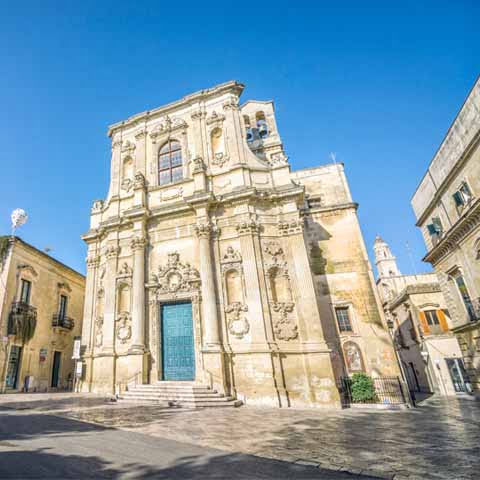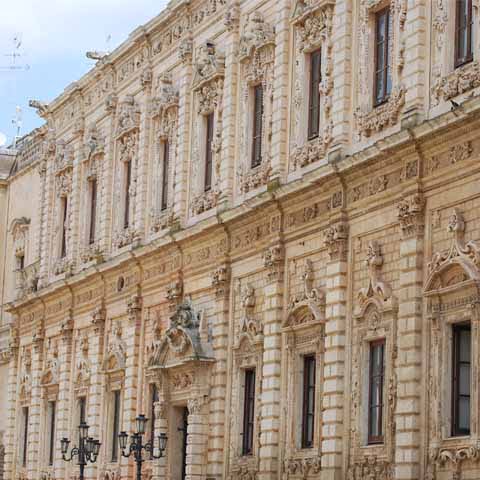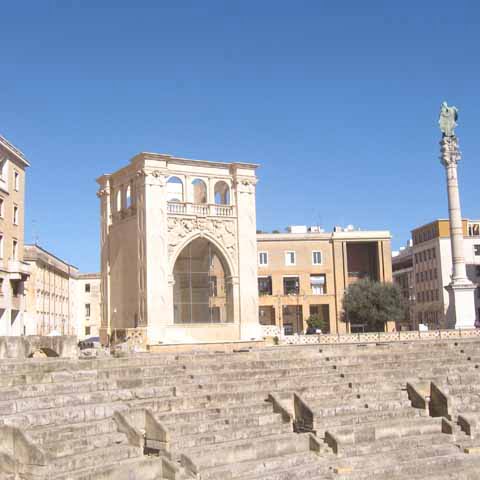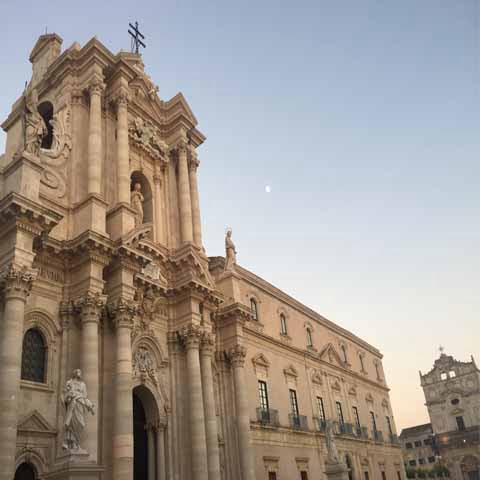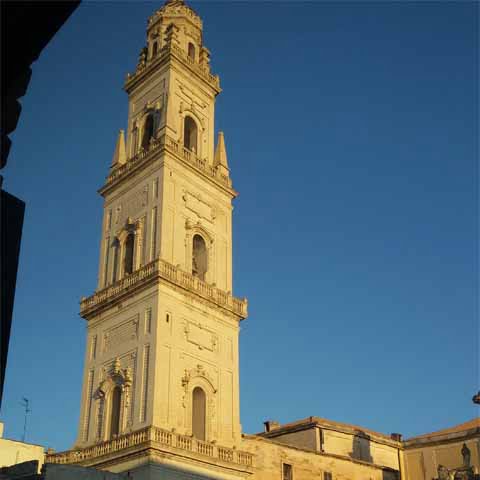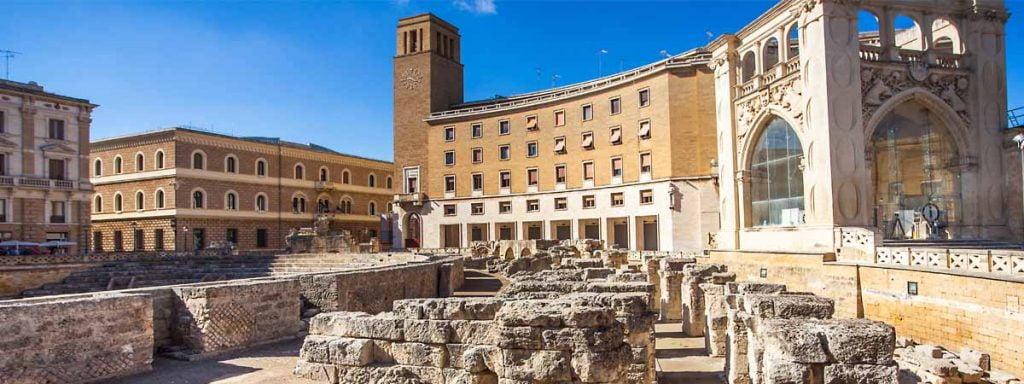The southeastern city of Lecce in the region of Apulia overflows with breathtaking culture that is a product of ancient history and rich tradition. This populous city of over ninety thousand on the Salento Peninsula is home to a vast number of buildings and monuments that tell a story of the city’s ancestors and their impact on future generations. To truly soak in all of the enchanting treasures of Lecce, plan to spend at least a day or two wandering this gorgeous city.
ARCHITECTURE
The pride and joy of Lecce is hands down the abundance of Baroque architecture present in building after building throughout the city. This distinction has in fact earned it the nickname “The Florence of the South.” Lecce’s famous Baroque style can be admired throughout the city, particularly in local churches, civic buildings, and even the surviving city gates.
The Basilica of Santa Croce is the foremost example of Lecce’s beautiful Baroque architecture. This sixteenth century structure is made of the locally mined Lecce stone. While the building material of this church may be simple and singular, its overall appearance is anything but those things. To even describe this basilica as wildly grandiose feels like an understatement. The façade of the church is elaborate and ornate, with thousands of tiny details in the carvings, statues, and gorgeous upper rose window. Though the exterior is no doubt breathtaking, the interior is also elegant, featuring multiple tall columns, wall carvings, stately chandeliers, and works by local artists such as Francesco Antonio Zimbalo.
Another stop should include the Cattedrale dell’Assunzione della Vergine, which is Lecce’s Cathedral. Though this building is more understated in its design compared to the Basilica of Santa Croce, it is magnificent in its own way and is considered to be one of the most important religious buildings in the city. The church was established in the twelfth century but received multiple renovations throughout the years. The Baroque architecture beautifully complements the other buildings in Piazza del Duomo. The exterior of the cathedral is in a monotone dark cream color derived from the Lecce stone, which during sunset takes on a remarkable pink hue. Above the entryway is an exterior balcony featuring intricate design and several statues, making the cathedral’s façade another excellent example of Lecce’s Baroque architecture. The interior of the church is picturesque with multiple high arches and gold detailing along with historical artwork on the ceiling. The defining characteristics of the Lecce Cathedral are its twelve chapels and the large Baroque bell tower to the left of the building that stands approximately two hundred thirty feet tall.
The Church of Santi Niccolò e Cataldo is one of Lecce’s oldest churches. Originally built during the twelfth century under orders of the Normans, the church was restructured in the Baroque style during the eighteenth century. Like many of Lecce’s stunning churches, the Church of Santi Niccolò e Cataldo was built using Lecce stone. The façade features several Baroque statues and decorations that were added to the church as well as the original portal, which was constructed in the Romanesque style. Once inside, travelers can admire Renaissance and Baroque frescoes as well as intricate Baroque altars and statues dating back to the sixteenth century.
The Basilica of San Giovanni Battista al Rosario is also emblematic of Lecce’s unique Baroque architecture. The extravagant façade is composed of Lecce stone and is richly decorated with statues, columns, and carvings. The church was the final work of architect Giuseppe Zimbalo (also known as “Zingarello”), who is considered to be one of the masters of Lecce Baroque. Zimbalo worked on several other local churches as well, most notably Lecce’s Cathedral. The interior of the Basilica of San Giovanni Battista al Rosario houses a beautiful Baroque pulpit built with the local Lecce stone that depicts the Apocalypse.
Giuseppe Zimbalo was also the architect behind Palazzo dei Celestini, which served as a convent for local Celestine monks. A previous structure was built on the site during the fourteenth century, which was eventually replaced by the current Baroque convent during the sixteenth and seventeenth centuries. The exterior of the building is decorated with elaborate symbols and motifs that are characteristic of Lecce’s Baroque architecture. The convent closed during the nineteenth century and today the building hosts the government of the province of Lecce.
Another influential architect during the Baroque period was Giuseppe Cino, who designed the reconstructed Church of Santa Chiara. The original structure was built in the fifteenth century, while Cino’s Baroque additions were completed at the end of the seventeenth century. Though unfinished, the church’s façade is renowned for its beautiful decorations featuring angels and its chiaroscuro appearance. The interior is notable for its intricate chapels, altars, and statues.
The Church of San Matteo is a seventeenth century Baroque building with a beautiful white exterior. A large wooden entryway door is guarded by columns on either side. Be sure to look for the tiny artistic details carved into the stone of this building, which include angels and symbols. The interior of the building is largely a continuation of the outside theme with stunning arches, statues, and carvings on either side of the pews. Of particular interest is the richly decorated High Altar that is dedicated to San Matteo.
In addition to churches, Lecce’s stunning Baroque architecture may be admired in its civic structures as well. Among these are Lecce’s striking palaces, such as Adorno Palace. Constructed during the sixteenth century, Adorno Palace is the work of architect Gabriele Riccardi. Located in front of the Palazzo dei Celestini, Adorno Palace is known for its smooth external façade and diamond point interior decorated with objects carved out of Lecce stone.
In contrast to Lecce’s characteristically ornate Baroque architecture, De Rinaldis Palace has a relatively bare late-Renaissance façade. One key detail is the balcony, which is supported by anthropomorphic statues and is notably asymmetrical. Additionally, the building is positioned on a slope, giving it a particular incline.
Marrese Palace is considered to be one of Lecce’s most highly regarded palaces thanks to its elegant façade. Divided into two parts by a balcony, the façade features anthropomorphic pillars and a central entrance portal. Dating back to the eighteenth century, the palace provides an excellent example of less elaborate, yet equally stunning, local Baroque architecture.
Another key palace is Tamborino Cezzi Palace, which features a late-Renaissance style. At the end of the nineteenth century, part of the building was restructured with Neoclassical and Art Nouveau elements. In addition to the stately façade, the palace is revered for its nineteenth century garden featuring a variety of flowers, trees, and other plants.
Other Baroque structures worth admiring include Lecce’s three surviving city gates. The most renowned among these is Porta Napoli, which also serves as a triumphal arch. The gate dates back to the sixteenth century and is dedicated to Charles V. The name of the gate refers to the fact that it was positioned on the route that connected Naples and Lecce. The monument consists of a central, round arch framed by a column on each side.
On the eastern side of the city, travelers will find Porta Rudiae. This structure is thought to be the oldest gate and is characterized by a large single arched entryway accented with sculptures representative of the city’s founders. Destroyed in the seventeenth century, the current structure features a Neoclassical style with Baroque elements.
Of the three remaining gates, Porta San Biagio is the southernmost of the city. This gate is distinctive due to the presence of the Lecce crest and the statue of St. Blaise that sits atop the archway. The arch is framed by columns and it also features the coat of arms of Ferdinand IV of Bourbon.
One of the symbols of the city is the Column of Sant’Oronzo, the patron saint of Lecce. The original column was built by the Ancient Romans and once stood in Brindisi at the end of the Appian Way. The column was eventually gifted to the city of Lecce by Brindisi, after Lecce’s patron saint is said to have saved Brindisi from the Plague of 1656. In 1666, the statue of Sant’Oronzo was added to the top of the column and has blessed the city of Lecce ever since.
ART
Truly, much of Lecce’s art is found in the gates and buildings of the city itself. While it is common for many of Italy’s cities to boast unique and gorgeous period architecture, art is an active part of Lecce’s buildings. Whether it is the grandiose details, statues, or archways, Lecce is a masterpiece and amazing work of art all on its own.
One of the best-known arts in Lecce, which is not as common in the rest of Italy, is the art of papier-mâché. The city has a whole museum dedicated to this craftsmanship named Museo della Cartapesta which is found inside the Castle of Charles V. This art, locally referred to as cartapesta, became popular in the seventeenth century and has since prevailed. Look closely as you tour the city and you will find papier-mâché incorporated in churches, statues, and even some ceiling decorations. There are still some that practice the art today and make designs that can be found for sale in local shops. The creations of local papier-mâché artists such as Francesca Carallo are quite popular here.
The Gallery of Franciscan Art is a unique museum where art from the convents in Lecce and the surrounded province is on display. Inside visitors can admire papier-mâché art, liturgical vestments, and paintings by local artists. The list of artists represented here includes Father Raffaello Pantaloni, Ezechiele Leandro, Serafino Elmo, Oronzo Tiso, and more.
In addition to Lecce’s famous Baroque architecture, other buildings are noted as works of art as well, such as Carafa Palace. Constructed in the Rococo style, the palace is actually a restructured monastery from the sixteenth century. Today the building hosts Lecce’s local government, and inside the palace, visitors can admire the sculpture Combattimento tra un gladiatore e un reziario by local sculptor Eugenio Maccagnani.
LITERATURE
With Lecce’s flourishing of the arts, it is no surprise that literature was and is a part of that creative movement.
The Ancient Roman writer and poet Quintus Ennius was born in a small town near Lecce. Ennius was best known for his plays as well as the epic poem Annales, which traced Roman history from approximately 1184 B.C. to 184 B.C.
Born in Lecce, Scipione Ammirato was a sixteenth century historian and avid writer who documented historical events and genealogies. Among Ammirato’s many works are Delle Famiglie Nobili Napoletane, Discorsi sopra Cornelio Tacito, and Istorie Fiorentine.
Perhaps Lecce’s most important native writer was Vittorio Bodini, who was a poet and translator. Though Bodini was born in Bari, he grew up in Lecce and spent his formative years in the city. Bodini was part of the Futurist movement and founded a Futurist group in Lecce known as Futurblocco. He is highly regarded as one of the best Italian translators of Spanish literature. Bodini’s original poetry often featured descriptions of Lecce, and today some of the poet’s most famous lines can be found on plaques and art throughout the city.
MUSIC
One of the largest symbols of music’s presence in Lecce is the Teatro Politeama Greco. This nineteenth century theater is fittingly quite grand, much like the music and culture it showcases. The building was recognized as a Theater of Tradition in 1979 and is four stories tall with an interior that includes rich, ornate balconies and beautiful frescoes on the ceiling. The theater is most commonly home to operas and classical music concerts.
One of the past directors of the Teatro Politeama Greco was Lecce native Tito Schipa, a world renowned twentieth century Italian tenor. He is considered to be among the most revered tenors of his time and traveled throughout the world, including Italy, Argentina, the United States, and the Soviet Union.
Cloe Elmo was a twentieth century mezzo-soprano born in Lecce. She began singing at a very early age and traveled the country. For a time, she sang at La Scala in Milan as well as at the Metropolitan Opera in New York City.
Opera is not the only music celebrated in the city. The Locomotive Jazz Festival is an annual event in Lecce that has been celebrated for more than ten years. The event celebrates all types of jazz with a focus on the universality of music.
CINEMA
Thanks to its unparalleled beauty, Lecce has served as a setting for several Italian films over the years. Most notably, Turkish-Italian director Ferzan Özpetek has filmed a few of his works in Lecce including Mine vaganti (2010) and Allacciate le cinture (2014).
Other Italian and international movies filmed in Lecce include Melissa P. (2005), Piede di Dio (2009), and Walking on Sunshine (2014).
SCIENCE
Over the centuries, Lecce has been home to several notable Italian scientists. Among these was Cosimo De Giorgi, a physician who published research in a number of fields including archeology, paleontology, and geology. Another Lecce native, Ennio De Giorgi, was a notable mathematician whose work on partial differential equations contributed greatly to the field of mathematics.
It is simply impossible to wander the streets of Lecce and not be taken aback by the gorgeous beauty of this city’s thriving culture. Journey to Lecce and take in the ancient history and rich tradition of this lovely city of Italy.
Don't just see Italy, live it.
Your dream trip to Italy has never been closer
No more endlessly scrolling travel sites. Our travel experts will craft the perfect, one-of-a-kind trip just for you.

300+
DESTINATIONS
We offer more Italian destinations than any travel site. Do and see more with Trips 2 Italy.
1 (of a kind)
ITINERARIES
Because your dream trip to Italy should be designed for you, not for the masses.
100%
PEACE OF MIND
From flights and accommodations, to food and activities - we take care of every detail.
